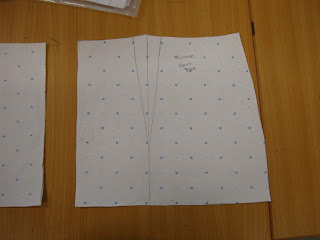skirt step by step
step one : I cut out all of my pattern pieces and pinned the two side seams together
step two: I then proceeded to sew the seams together with a 1.5cm seam allowance
step three: I then pinned in 2 darts into the front panel of the skirt to about 5cm down the front of the skirt, sewing along the pinned area before sewing backwards 2cm to secure the seam and stopping it pointing out.
step four: repeated step 3 on the back panel.
step five: I pinned together the other side seam before sewing straight down to create the seam (1.5cm)and securing the stitch
step seven:I repeated step two to five.
step eight: put the right sides off the skirt together and pin
step nine: sew along the hem (1.5cm seam allowance) and secure the stitch and turn the skirt the right way out.
step ten:I then cut out a piece of fabric ( 10 cm in width) for the waistband
step eleven: I then pinned to right sides of the waistband and the skirt together.
step twelve: sew along the waistband and skirt all the way around (1.5cm seam allowance)
step thirteen : press a line (1.5cm) and the un sewn area of the waistband and pin along the right side of the skirt and top stitch 0.5cm away from the waist band edge and secure the stitch.
step fourteen: cut any loose threads and the skirt is complete.
top step by step
step one: cut out all the pattern pieces
step two: pin the front bodice and side front panels together
step three: sew straight along the seam 1.5cm seam allowance and secure the stitch
step four: repeat this on the other bodice panels.
step five: fold over the edge of the back panels (about 2cm) and press
step six: measure out the correct and even placing for your eyelets mark the fabric with tailors chalk
step seven: get the fabric hole punch and a hammer
step eight: line the punch up with the marks you made on the fabric
step nine close the punch on the mark and hammer until a hole has been made continue this with all the marks made on the fabric
step ten: place an eyelet into the first hole hold and place use the eyelet finisher to secure the eyelet continue with all holes
step eleven : pin bandages onto corset and sew 0.5cm away from the edge of the bandage sew both edges of the bandage
step twelve : continue sewing the bandages to the corset until its covered
step thirteen: lace up corset with choice of ribbon or in my case bandages
step fourteen: cut any loose threads and the corset is complete.







































